It's an understatement to say that the pandemic has changed the world for good. The implications have been felt all the way from 2020 until today.
This article covers how HR and management will continue to change, and the top 10 trends that will be prominent in 2023.
Between 2020 and 2021, our research found that there is a 17% decline in employees who are confident in their organization’s future - from 81% to 64%. This number now stands at 45%.

Source: EngageRocket's research
We've also observed the rapidly growing gig and remote work economy as organizations seek talent beyond their local borders.
Unsurprisingly, many employers were not keen on adopting flexible work practices, resulting in people feeling unhappy and unfulfilled at work. This eventually led to the phenomenon we know as the Great Resignation.
Today, we're faced with new challenges that affect workforces - from 'Quiet Quitting' (or some would say, 'Quiet Firing') to rapid firing by major global companies in an effort to sustain their business.
💡Get the curated list of 2023 predictions from the world's best. Featuring reports, guides, and thought pieces from prominent industry leaders such as Gartner, BCG, Deloitte, The Economist, and more.
Table of contents
2. Organizations taking drastic measures to sustain through economic uncertainty
3. The talent war quickly became a zero-sum game
4. The 'decentralization' of HR requiring managers to step up
5. Focus on employee analytics replacing gut feel in decision-making
2. Four-day work week might be the 'new normal'
3. Quiet quitting turning into 'silent insecurity'
4. Supply of remote jobs starts to dwindle despite increasing demand
5. Career mobility and upskilling will be top priorities for employees
6. Continued shortage of labor supply as populations age and countries tighten foreign hiring policies
7. Higher standards for a better workplace
8. Adoption of AI will be prominent in people management practices
9. New expectations around health and well-being
10. The shifting requirements of HR skills that will be relevant
To understand how we arrived at where we are today, let's look at the trends that sprung up in 2022 and how the future of work will evolve in 2023.
Workplace trends observed in 2022
1. The 'new way of working' has become the demanded default
Most organizations don’t truly understand what makes people want to stay or leave. They tend to revert to salary and benefits as their guideposts to retain people.
The result?
Rushed decisions towards going back to the old ways.
Forced return-to-office rules.
Policies that make people sigh and look for a new job during work hours.
On the other hand, we saw a handful of companies that try to embrace that the world has changed. AirBNB's work-from-anywhere policy, for example, is befitting of their brand and their employees' expectations.
Employers looking to prepare for 2023 should take note of what drives employees to stay - especially within their own workplaces.
2. Organizations taking drastic measures to sustain through economic uncertainty
By the time this post is published, at least 3 of the FAANG companies have laid off their staff, and layoff plans for the remaining 2 have been leaked to the public.
Facebook (or rather, Meta) has infamously laid off more than 11,000 of its workforce. Netflix had two waves of layoffs in the mid of 2022. Apple had let go of its recruiters as they slowed down hiring. Amazon is in the midst of layoffs and Google is heavily rumored to lay off thousands of employees.
Twitter is another company stirring up a debacle with its layoffs. Asian-based unicorn startups such as Gojek and Shopee have also let go of a large portion of their workforce. This doesn't even take into account the non-tech companies.

The piling list of tech companies layoffs in 2022
Source: Visual Capitalist
What had happened? Why now, when we're finally exiting the peak pandemic period?
The forecasted economic bounce back had never fully come to fruition. Companies overestimate people's spending intent and power post-pandemic. The ongoing war and conflicts across the world have taken a large economic toll on a global scale.
We will still see the aftereffects of these decisions as we enter 2023, as we see both employers and employees being more cautious about hiring opportunities.
3. The talent war quickly became a zero-sum game
The labor shortage in many countries has been a spotlight throughout 2022.
If we put statistics aside, there are only a few companies that are widely known as top employers within a region. Job applicants tend to flock to these desirable companies in the hope of securing more attractive roles.
On one hand, we have the 'attractive' companies attracting thousands of talent every year. On the other hand, we have companies struggling to fill in one position for months.
This results in a “winner take all” zero-sum game due to limited talent availability in the short term.

The talent war is almost as harsh as Squid Game's tug-of-war
4. The 'decentralization' of HR requiring managers to step up
'Decentralization' may sound like a big word, but it simply means that HR can no longer be the all-seeing eye for everything.
Before, HR would be the one who had access to all employee engagement data, performance, and progression. If a manager wishes to take certain actions for one of their team members, they would go to HR.
However, with remote and hybrid work becoming commonplace, HR might be too far removed from the day-to-day operations to give practical advice.
This is good news for both HR and managers. It means HR can focus more on implementing strategies to retain people, improving operational efficiency, and being more involved in business growth. Managers also have more autonomy and need to be more hands-on with their own teams.
This doesn't mean that HR should (or could) offload their duties to managers. On the contrary, they should find more ways to empower managers to better support their teams.
5. Focus on employee analytics replacing gut feel in decision-making
Today’s business leaders are expected to be data-driven and use data as an important source of input when making decisions.
83% of leaders want their organizations (and themselves) to be more data-driven.
In the old days, this used to translate to make wiser financial decisions, setting up better marketing budgets, or improving sales operations.
But we're also seeing the effect this mindset has on making decisions that affect workplace policies.
Rather than relying on trends, hearsay, and mimicking trends, more and more leaders are seeing the value of taking action based on employees' feedback.
This is a great step in the right direction as so much can be achieved when leaders listen inwards, not outwards.
---
Now that we've taken stock of all the prominent HR trends in 2022, let's dive into what the future of work will look like for 2023.
Looking ahead: 10 major workplace trends that will be prominent in 2023
1. Organizations taking a more cautious approach to hiring and recruitment
With all the layoffs towards the end of 2022, organizations of all sizes are now taking stock of their capacity to scale. Report by LinkedIn in October 2022 confirms this - hiring is leveling off after historic highs.
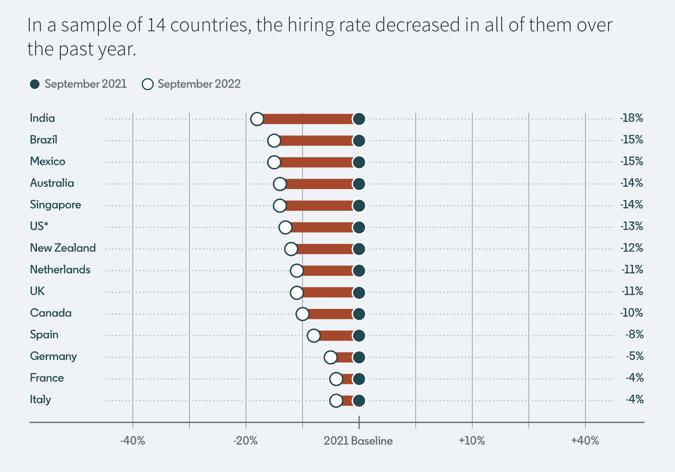
The decrease in hiring rates happening globally
Source: LinkedIn
With hiring becoming a lower priority, this shifts the focus to strategic retention for many organizations.
What does this mean?
It means trying to achieve more with less - without burning out existing employees. Streamlining operations, cutting down inflated budgets, and automating certain tasks are on the agenda for many businesses.
Another consideration to take into account is employees' level of morale and well-being. Colleagues leaving, and fewer open roles mean increased workload and burden on those who stay.
Employers need to be mindful of this fact and take a proactive approach before it snowballs into high-performers calling it quits.
Our recommendations:
-
Managers need to be trained on spotting and mitigating signs of burnout. Since managers are closer to the grounds, they will be best positioned to detect early signs of employee burnout. Equipped with individualized information about their team members, managers also have the knowledge of how to support employees. Consider getting feedback from managers on what resources or support they need to address potential burnout problems.
-
Map out the skills your business needs, and the skills your employees have. With fewer people potentially doing more work than before, there's bound to be some compromise. If your workforce has been affected by increased workload, streamlining efforts should be on your priority list.
-
Offer training and reskilling opportunities around process redesign and automation. To sustain or even grow productivity levels with fewer resources, organizations need to relook at their processes and find ways to optimize them. Automation can help employees be more effective and focus on work that creates more value. That way, they are less burdened by the increased workload and are less susceptible to burnout.
-
Build a culture of recognition. Showing employees that they are valued for their contributions to the organization will help motivate and boost employee morale. Nowadays, there are numerous platforms designed to help with recognition. Here's a list of employee recognition platforms you can consider.
2. Four-day work week might be the 'new normal'
The notion of a four-day workweek used to be a novelty for most of us. It just seems too good to be true
The benefits have been well reported both on employers' and employees' side. While the upside is rather obvious on the employee's side (who wouldn't want an extra weekend?!), there are surprising benefits on business numbers as well.
French company LDLC saw a 40% increase in revenue following their four-day workweek implementation.
Okay, all of us (even CEOs and business magnates, presumably) want an extra day off. But how does it work?
Does it mean 40 hours worth of work are crammed into a mere 32?
What about customer-facing functions?
Should they not reply to customer inquiries during the additional day off?
This image best represents the dilemma that many leaders face when thinking about implementing a four-day workweek
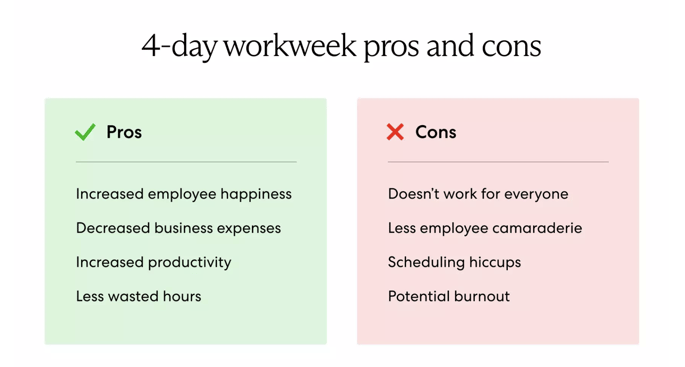
Weighing the pros and cons of the four-day workweek
Source: Velocity Global
Now, many companies have started adopting a four-day workweek. Some saw success, and yet some struggled to fit their busy schedule into a mere four days.
A common thread across those that succeed is a shift in mindset - mainly trust and streamlining workload.
It means making giving employees the needed additional day off without worrying if they will 'contribute more'. When people feel heard, recognized, and rewarded, we naturally want to contribute more.
We should also avoid expecting people to do more in less time. Rather, it's about focusing our efforts on things that bring value to the business. This is good business practice regardless of four or five days of work. The four-day workweek simply pushes businesses to better evaluate what they should be spending their time on.
While the 4-day workweek model may not be suitable for all companies (at least for now), it's still a worthwhile option to explore. For those looking to at least try it out, see our recommendations below.
Our recommendations:
-
Ask teams to evaluate and prioritize key business drivers. Team managers and department heads should discuss with their team members and come to a decision on how they can streamline the workload to fit a shorter work week. The decision should be guided by what projects/tasks provide the greatest value to the business. Assign managers with the responsibility of coming up with goals and action plans to make a four-day workweek feasible for their respective teams.
-
Set up protocols for customer-facing functions. The practice of job sharing has been widely implemented for a very long time, and this practice can be implemented to fit the four-day workweek practice. For example, one batch of employees can work from Monday to Thursday, and the other batch from Tuesday to Friday. If cost or manpower is an issue, consider automating parts of the job where possible.
-
Start with an experiment and set clear expectations. Like all important business decisions, you may consider starting with a pilot project - the idea here is to test out the feasibility of the four-day workweek. Make sure to communicate to employees what the change entails. Cascading goals and expectations is always a good practice, and is even more important to do in this context.
3. Quiet quitting turning into 'silent insecurity'
Earlier in 2022, the term quiet quitting spread like wildfire as it describes the situation that many people experienced (but might not realize).
With news of layoffs recently, we're seeing this sentiment shift into feelings of job insecurity - one we could describe as 'silent insecurity'. This will likely remain prominent going into 2023.

Feelings of job insecurity are picking up again in 2022
Source: Gallup
Research has shown that feeling insecure about job stability has negative impacts on well-being and productivity. It affects employees' sense of identity, social connections, physical health, and mental health.
What's likely to happen as a result is reduced motivation and the tendency to disengage from their work and role, similar to the quiet quitting phenomenon.
The difference with 'silent insecurity' is that people will likely force themselves to perform and be productive, so they won't lose their jobs. This could lead to feelings of isolation and burnout.
Such sentiments are counter-productive when employers are struggling to sustain and grow the business. Mitigating risks of disengaged employees from feeling the 'silent insecurity' is important for organizations to thrive.
Our recommendations:
-
Communicate visions and plans transparently. When employees do not know why they are doing certain things, they detach themselves from the organization at large. If the company vision is communicated in a way that allows employees to understand how their work serves a larger purpose, they will be more motivated and driven.
-
Understand the causes of insecurity (and possibly disengagement) for different people. Rather than relying on speculations, it's better to hear from employees directly. Most individuals would have different reasons for being disengaged or fearing for their job stability. Getting employees' feedback either through confidential surveys, 1:1s with managers, or group discussions would be a good start.
-
Empower managers to spot the early signs. Managers are closest to employees' day-to-day operations. They can help nip any potential issues in the bud before they snowball. Some key signs you should look out for decreased motivation levels, lack of participation in team activities, reduced communication between colleagues, increased absenteeism, and decreased productivity levels or quality of work. Consider getting a professional coach who can help managers identify verbal and non-verbal cues to address these signs.
4. Supply of remote jobs starts to dwindle despite increasing demand
Studies show that US remote job postings on LinkedIn reached 20% of all US jobs in February 2022 - yet they attracted over 50% of all applications.
By September, remote-job posts fell to 14% of all posts but got 52% of all US applications.
This shows that employees demand flexible working locations as a default, yet employers are hesitant to grant them.
It leads us to question: why?
What is so scary about allowing remote working, despite the fact that we've gone through it for at least 2 years, if not more?
A lot has been said about the difficulties of remote management. Connections and collaborations between colleagues have been brought up frequently as the main challenges in remote and hybrid work.
Here's the truth: many organizations are not prepared to face these challenges. And perhaps they don't want to be.
Nowadays, there are so many tools and resources to enable collaborative remote working - so we know enablement is not the issue here.
The issue might lie in the resistance to change. Research by Microsoft shows that 85% of leaders say the shift to hybrid work has made it challenging to have confidence that employees are being productive.
This resistance might come in different forms. Perhaps it's about having the mindset of trust. Perhaps it's about relearning what it means to be a good manager and a good leader.
However, data has shown that people are demanding flexible working arrangements. To hire and retain the best people, companies need to shift their approaches to remote and hybrid working.
Our recommendations:
-
Find areas of operations that allow for remote working. Allowing flexibility will help businesses gain a stronger footing in the war for talent. If it is not possible to allow fully remote work, then employers can start by giving opportunities for a portion of employees' work to be done remotely. Teams may be given the autonomy to decide how they would like to arrange this within themselves.
-
Set up guidelines and policies that allow for remote work. Often, we need to nurture an environment where trust can thrive. The most important aspect of trust in this context is knowing that work still gets done even when the person cannot be physically seen. Having a clear accountability framework for all workers - remote, on-site, or hybrid - makes it easy for everyone to have trust in each other.
-
Equip leaders and managers. As mentioned before, leaders and managers need to relearn what it takes to do remote management right. Nurturing connection and collaboration requires a different approach in a remote setting - as there is a higher risk that miscommunication can happen. Solutions such as EngageRocket's people enablement tool are developed to help leaders and managers navigate the challenges of remote management.
5. Career mobility and upskilling will be top priorities for employees
With feelings of job instability looming over, many employees will try and shift their focus inward.
Instead of aggressively pursuing opportunities elsewhere, employees will refocus on how they can best maximize their upskilling and career growth in their current company.
LinkedIn’s 2022 Global Talent Trends report shows that upskilling and opportunities to grow at their current company are two of the top priorities for today’s workers.

How career mobility affects loyalty and intent to stay at current company
Source: LinkedIn
Combined with the fact that hiring is leveling off, this provides a great insight on how employers could look to retain and engage their current workforce.
The great news is that it aligns both employers' needs and employees' expectations.
Organizations looking to prepare for the coming year should pay attention to how they can prioritize internal mobility over external hiring.
Our recommendations:
-
Initiate or experiment with personalized coaching and training programs. Nowadays, there are many consultancies and platforms providing individualized services and platforms. Running a pilot project would help employees figure out their skillset that can be valuable in other teams.
-
Make regular check-ins and performance reviews a habit. Managers need to be accountable for staying on top of their team members' well-being, productivity, and performance. For starters, having regular reviews (e.g., quarterly) with employees on career growth needs to be the de facto managerial operations. Both employees and managers would also benefit from having more frequent 1:1 check-ins, with a bi-weekly or monthly cadence.
6. Continued shortage of labor supply as populations age and countries tighten foreign hiring policies
The percentage of working-age Americans either employed or looking for work sank from 63.4% to 60.2% during the peak of the COVID-19 pandemic.
While that figure has recovered somewhat to 62.4%, the longer-term outlook is for further decline.
U.S. workforce participation, in fact, has been falling steadily for more than two decades since peaking at 67.3% in 2000.
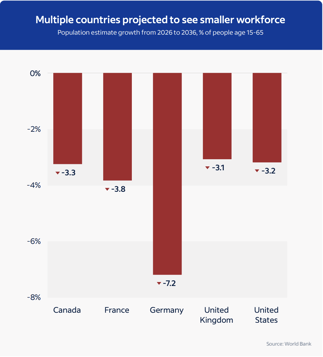
Reduced number of population within the productive age group across countries
Source: SP Global
The most recent data shows that there are 10.7 million job openings in the U.S. and 1.7 jobs available for every unemployed worker.
This is not a concern only in the U.S. — right now there are over 6 million job openings in Europe, 470,900 vacancies in Australia, and over 1 million openings in Canada.
Countries in Asia are also grappling with the labor shortage, with millions of employees quitting in search of more meaningful work and better pay.
We're seeing a trend here - reduced hiring, labor shortage, and people looking for opportunities within their own organization. They're all clear signs that it's time for organizations to focus on better retention strategies (and not just lip service!)
Our recommendations:
-
Analyze causes of attrition. I must have highlighted this more than ten times in this article, but there is no better strategy than to focus on retention. That being said, attrition is a part of the bread and butter of our professional lives. What HR and leaders can do is analyze the causes to minimize regrettable attrition (e.g: high performers resigning). This helps you to focus and improve on the pain points that are driving people to exit.
-
Consider part-time and freelance contracts. Slow hiring and low labor supply do not mean there is less work for existing employees. To help ease their burden and reduce burnout risks, make it easier for managers and employees to outsource work. It's good practice to review your policies and see where you can streamline the process for them.
-
Review diversity and inclusion policies. In times of low labor supply, you would not want to alienate good potential candidates. Identify areas for improvement in your DEI policies, so you can gain access to a wider population, such as older employees and minority groups.
7. Higher standards for a better workplace
The pandemic didn't only transform the way we work.
It also transformed the way we think about work.
"Why do I have to go back to the office three times a week? I was doing great with remote work"
"Why wouldn't my boss allow me to work from home? It allows me to spend more time with my child"
These are some of the common thoughts that people would have nowadays.
They would not occur to most employees before, but now every other person you meet would probably have these thoughts.
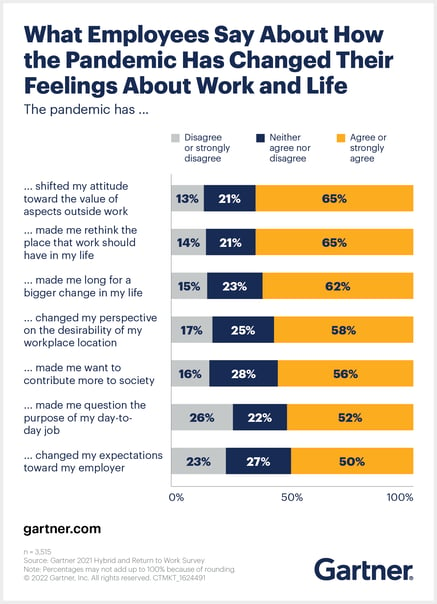
The effects of pandemic on employees' mindset
Source: Gartner
We were forced to move swiftly during the early days.
Coming up with health policies, virtual learning and development, and remote onboarding.
Now? We stopped.
When faced with remote or working hybrid challenges, the standard response is:
Oh well, let's just get people back to the office.
What we might overlook is that while the demands of work remain the same, the people doing the work have different perspectives now. What might be good enough back then may not even be on par today.
These newly formed expectations put employers to the test: how well are we able to change along with the times?
Our recommendations:
-
Get feedback on what employees feel and need. Employees who are engaged and fulfilled are more likely to have positive experiences, resulting in higher productivity and contributions. Get feedback on how the workplace can be further improved to match their expectations. Asking the right questions will help you gain insights and knowledge you might not have previously thought about.
-
Higher emphasis on well-being, mental health, and support systems. For employees, knowing that the organization they work for actually cares about them is an incredible motivator to stay. Place higher emphasis not only on the physical side but also on the mental and emotional side. Offer greater flexibility, expand on mental health coverage, or provide mentoring or coaching opportunities.
-
Empower managers to be the connecting bridge between team members and the organization. Managers hold the key to fostering cross-team connections as they know their team members at the individual level. Each manager should have the autonomy they need to allow and encourage cross-team collaboration.
8. Adoption of AI will be prominent in people management practices
AI has been a buzzword for the last couple of years now, and we don't expect people to stop talking about it soon.
Many innovative companies have leveraged AI to improve their service and product offerings.
In fact, many HR technology platforms have AI as part of their key offering. These platforms help organizations in optimizing for DEI, career paths, and learning and development (such as Phenom and Beamery).
With the recent release of ChatGPT by OpenAI, we might see the use case extending to human interactions at work.
The model is designed to interact with humans in the most fluid, conversational way.
Here's an interesting snippet from the platform, when a user asks a question in a very natural way:

Human-like recommendations coming from ChatGPT
Source: OpenAI
One of the major complaints coming from managers is how time and resource-constrained they are.
Sharing genuine feedback, giving suggestions for improvement, and check-in are often areas that managers struggle with when it comes to dealing with team members.
Organizations that are proactive about empowering managers should be mindful of helping them achieve success.
While formal training and leadership workshop have their values, they are not always helpful for managers in the actual day-to-day management.
Enabling managers to become an even better version of themselves requires a more hands-on solution that can positively improve their interactions with team members.
Our recommendations:
-
Keeping abreast of key innovative trends. When a new technological tool is developed and relevant for the organization, there should be some consideration to adopt it for first-mover advantage.
-
Upskilling for HR and leaders in workplace tech. While HR and leaders are quick to jump on the bandwagon to uplift others, they usually put their own learning agenda on the back burner. Workplace transformations are often championed by HR and the leadership team. It follows that they must know how to utilize evolving technologies that make their workplaces better.
-
Adopt AI-assisted people management tools. EngageRocket's people-management tool is aimed at helping busy managers conduct better management practices. The smart AI assistant helps managers stay on top of employee milestones, share genuine feedback and improve team performance.
9. New expectations around health and well-being
46% of people say their expectation around happiness at work has increased in the last year.
Demands for better health and well-being benefits have increased.
This is expected as costs of living have increased in many parts of the world due to many political and economic reasons.
On the other hand, employers are already finding it hard to sustain their businesses
According to studies done by Mercer and SHRM, health benefit costs continue to increase - and it's taking a toll on many employers and businesses.
Without squeezing costs and compromising employees' health and well-being, there are areas employers can focus on to provide more comprehensive care.
Our recommendations:
-
Invest in end-to-end well-being platforms and initiatives. Go beyond employee assistance programs (EAPs) and mental health days that offer occasional and reactive support. Adopt comprehensive care platforms that support employees in their end-to-end well-being journey.
-
Guide managers to enable safe spaces for mental health conversations. Empower managers to be mental health champions within their teams. Provide a library of resources and coaching that guide managers on how to conduct mental health conversations.
10. The shifting requirements of HR skills that will be relevant
We are long past the era when HR's main duties were only to process paperwork and do administrative stuff.
There are many different platforms out there that help in different HR operations.
To implement better workplace practices, modern HR needs to have varying skills beyond operational duties.
These skills range from workforce planning to employee analytics, and more.
With all the change we've been seeing in the past three years, this begs the question: how will the role of HR evolve in 2023?
This study conducted by Eightfold shows the skills that are trending sharply higher - and will remain high as we enter 2023
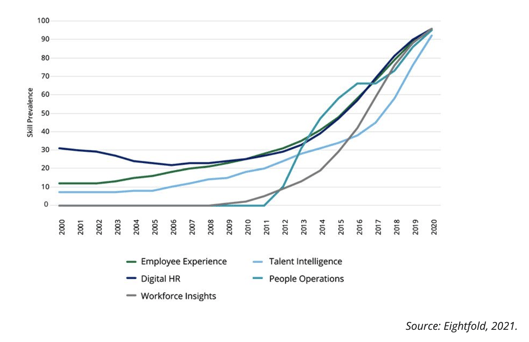
HR skills that will be relevant in the future
Source: Deloitte
Digital HR skills are trending up sharply, roughly correlating with the current global wave of digital transformation in organizations starting in the 2010s.
This further drives the point that an inward focus on existing talents is a key priority for many organizations.
On the other hand, we are also seeing downward trends for certain skills, as shown below.
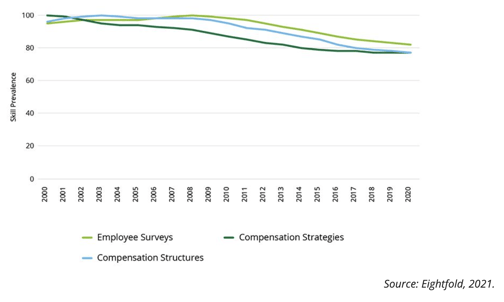
HR skills that are on the downward trend
Source: Deloitte
Nowadays, feedback gathering and insight analysis can be automated using platforms.
The role that HR takes in people analytics is becoming more focused on understanding the human side of business and exploring new ways the workforce can create and deliver value.
For organizations looking to future-proof their HR teams, it's important to be proactive when it comes to HR upskilling.
Our recommendations:
-
Make upskilling a key HR priority. While HR is quick to jump on the bandwagon to help others grow, they usually put their own growth on the back burner. Workplace transformations are often championed by HR and the leadership team. Hence, it follows that they must keep up with trends and evolving technologies that make their workplaces better.
-
Create a learning agenda for the HR team. Take note of the competencies your company needs and the competencies that are required for the future (such as the above). The next step is to identify which areas the HR team needs the most support with. This may be done through skills assessment or 360 reviews. After this, a plan can be set up to provide training, mentoring, or more to help with the upskilling. The team can then block off time to go through the necessary training and share their learnings with others.
Moving forward: it comes down to how prepared your leaders and managers are
We've covered all the trends in 2023 along with our recommendations for leaders and HR.
Can you guess what the common theme is?
EMPOWERING MANAGERS
I cannot emphasize enough how important, yet so easily overlooked this is. According to a study by Gallup, manager support accounts for 70% of the variance in employee engagement.
70%! That means if your employees are disengaged at work, you probably know why.
Gone are the days when managers were hired and promoted purely because of hard skills.
Managers today need to be able to coach, nurture, and engage with their teams. And they have their own responsibilities and workload on top of that.
In fact, it's been well-researched that managers are often trapped in a performance-compassion dilemma. Should they stand by their team's side or should they push them more so the business can achieve the annual target?
By the way, have I mentioned that managing people remotely is even tougher?
The bad news is it's difficult to find naturally good managers. There is too little time in the day, and too much to think about - especially with everything managers need to do on top of managing people.
The good news is being a good manager can be learned. Most managers are well-intentioned and would want to become better themselves. They are open to ideas that can help them connect and collaborate better with their teams.
Being able to guide your managers in practicing more empathy and efficiency may make or break your organization. So much relies on the managers that it cannot be left to chance.
How EngageRocket helps every manager become the dream manager
EngageRocket's innovation is aimed at helping busy managers conduct better management practices.
Our goal is to help everyone so no one can fail at being a good manager.
We enable this with a smart AI-assistant that helps busy managers stay on top of employee milestones, share genuine feedback and improve team performance.
Find out more about EngageRocket here.
About the author

CT Leong is the founder of EngageRocket. Before becoming an entrepreneur, he was a Regional Director of Gallup - one of the world's top HR advisories. He graduated with a degree in Economics from the University of Cambridge, and has an MA in Political Science from Columbia University.


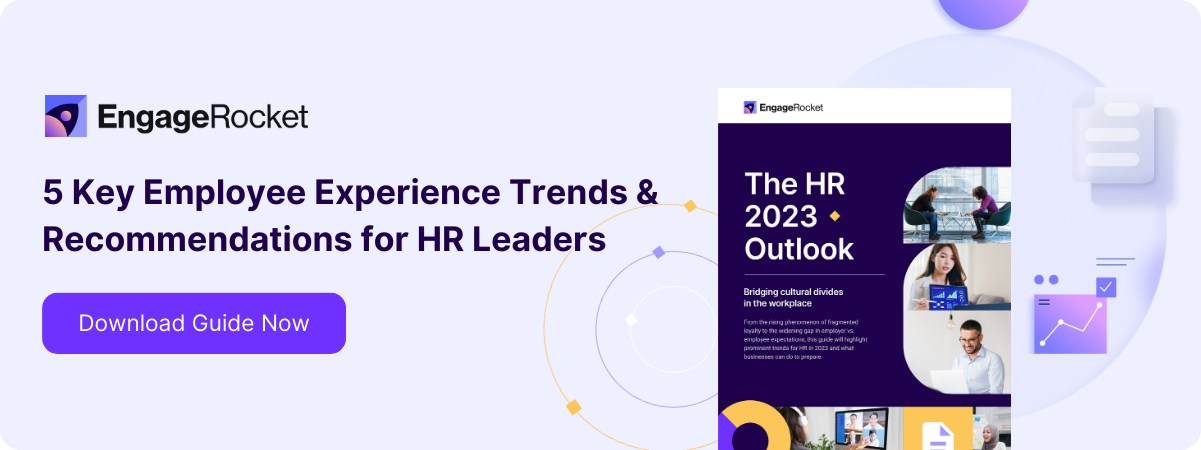

 .
. 